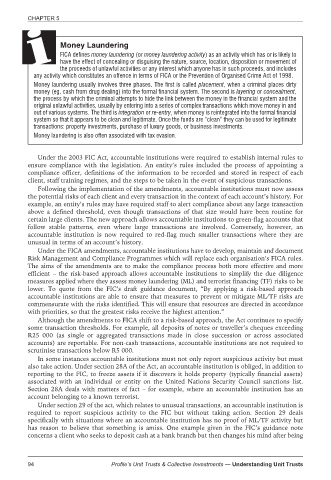Page 96 - Profile's Unit Trusts & Collective Investments - March 2025
P. 96
CHAPTER 5
Money Laundering
FICA defines money laundering (or money laundering activity) as an activity which has or is likely to
have the effect of concealing or disguising the nature, source, location, disposition or movement of
the proceeds of unlawful activities or any interest which anyone has in such proceeds, and includes
any activity which constitutes an offence in terms of FICA or the Prevention of Organised Crime Act of 1998.
Money laundering usually involves three phases. The first is called placement, when a criminal places dirty
money (eg, cash from drug dealing) into the formal financial system. The second is layering or concealment,
the process by which the criminal attempts to hide the link between the money in the financial system and the
original unlawful activities, usually by entering into a series of complex transactions which move money in and
out of various systems. The third is integration or re-entry, when money is reintegrated into the formal financial
system so that it appears to be clean and legitimate. Once the funds are “clean” they can be used for legitimate
transactions: property investments, purchase of luxury goods, or business investments.
Money laundering is also often associated with tax evasion.
Under the 2003 FIC Act, accountable institutions were required to establish internal rules to
ensure compliance with the legislation. An entity’s rules included the process of appointing a
compliance officer, definitions of the information to be recorded and stored in respect of each
client, staff training regimes, and the steps to be taken in the event of suspicious transactions.
Following the implementation of the amendments, accountable institutions must now assess
the potential risks of each client and every transaction in the context of each account’s history. For
example, an entity’s rules may have required staff to alert compliance about any large transaction
above a defined threshold, even though transactions of that size would have been routine for
certain large clients. The new approach allows accountable institutions to green-flag accounts that
follow stable patterns, even where large transactions are involved. Conversely, however, an
accountable institution is now required to red-flag much smaller transactions where they are
unusual in terms of an account’s history.
Under the FICA amendments, accountable institutions have to develop, maintain and document
Risk Management and Compliance Programmes which will replace each organisation’s FICA rules.
The aims of the amendments are to make the compliance process both more effective and more
efficient – the risk-based approach allows accountable institutions to simplify the due diligence
measures applied where they assess money laundering (ML) and terrorist financing (TF) risks to be
lower. To quote from the FIC’s draft guidance document, “By applying a risk-based approach
accountable institutions are able to ensure that measures to prevent or mitigate ML/TF risks are
commensurate with the risks identified. This will ensure that resources are directed in accordance
with priorities, so that the greatest risks receive the highest attention.”
Although the amendments to FICA shift to a risk-based approach, the Act continues to specify
some transaction thresholds. For example, all deposits of notes or traveller’s cheques exceeding
R25 000 (as single or aggregated transactions made in close succession or across associated
accounts) are reportable. For non-cash transactions, accountable institutions are not required to
scrutinise transactions below R5 000.
In some instances accountable institutions must not only report suspicious activity but must
also take action. Under section 28A of the Act, an accountable institution is obliged, in addition to
reporting to the FIC, to freeze assets if it discovers it holds property (typically financial assets)
associated with an individual or entity on the United Nations Security Council sanctions list.
Section 28A deals with matters of fact – for example, where an accountable institution has an
account belonging to a known terrorist.
Under section 29 of the act, which relates to unusual transactions, an accountable institution is
required to report suspicious activity to the FIC but without taking action. Section 29 deals
specifically with situations where an accountable institution has no proof of ML/TF activity but
has reason to believe that something is amiss. One example given in the FIC’s guidance note
concerns a client who seeks to deposit cash at a bank branch but then changes his mind after being
94 Profile’s Unit Trusts & Collective Investments — Understanding Unit Trusts

